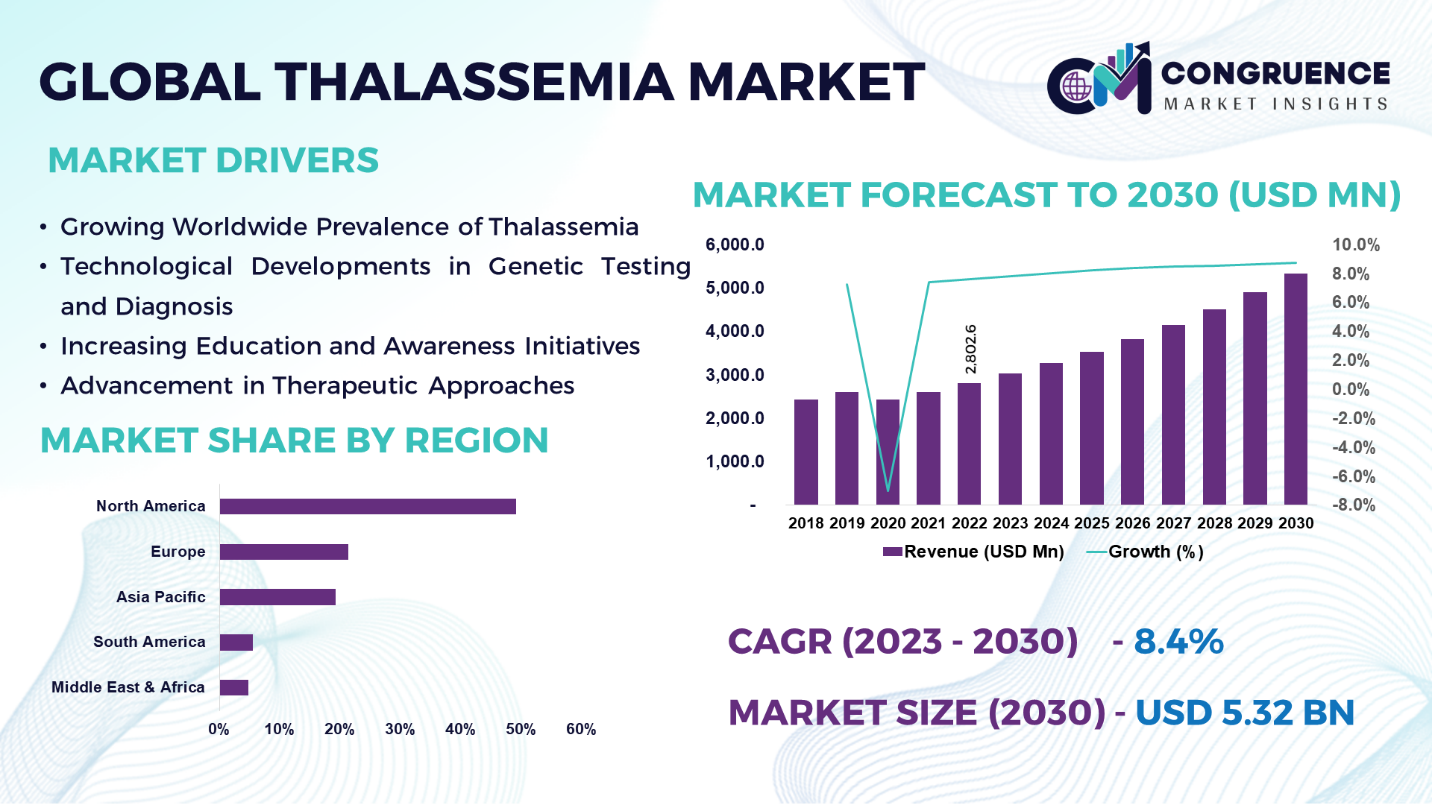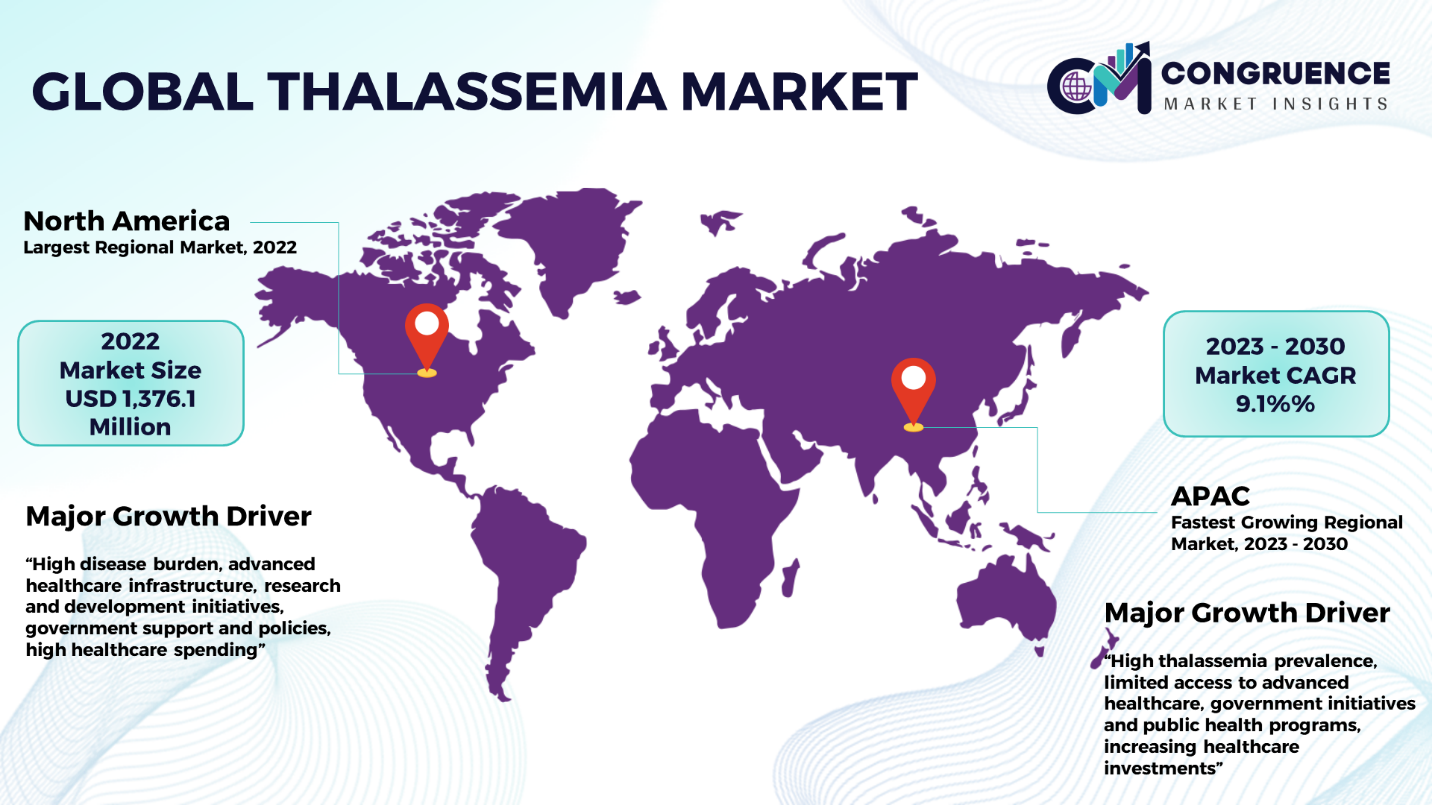Reports
The Global Thalassemia Market was valued at USD 2,802.6 Million in 2022 and is anticipated to reach a value of USD 5,321.9 Million by 2030 expanding at a CAGR of 8.4% between 2023 and 2030.
Anemia is caused by the breakdown of red blood cells caused by thalassemia, a rare genetic blood disease marked by the production of aberrant hemoglobin. Currently, the only available treatments are iron chelation therapy and blood transfusions. This creates a market with lots of potential for the creation of a thalassemia cure that works for everyone. Treating symptoms rather than curing thalassemia is the current approach to care. Treatments for the condition mostly target iron excess brought on by blood transfusions, vitamin supplements, fetal hemoglobin-raising medications, and indicaxanthin, an antioxidant that stops hemoglobin from breaking down. If medications presently in the phase II/III trial pipeline are approved by regulators, the market for thalassemia treatments is anticipated to have significant commercial potential. In developed regions such as North America and Europe, the market is driven by a rise in awareness of existing treatment modalities and the launch of novel treatment approaches. Furthermore, it is projected that in the upcoming years, there will be a greater demand for thalassemia medications and treatments due to the increased youth population in developing nations such as Pakistan and India.

Thalassemia Market Major Driving Forces
Growing Worldwide Prevalence of Thalassemia: One major factor driving up demand for diagnostic instruments, medications, and treatments is the global rise in thalassemia prevalence.
Technological Developments in Genetic Testing and Diagnosis: The demand for screening and testing services has increased due to the better accuracy and early identification of thalassemia brought about by these technological developments in genetic testing and diagnostic technologies.
Increasing Education and Awareness Initiatives: Raising knowledge of thalassemia, its effects, and the value of early detection and treatment has prompted more screening campaigns and educational activities, which has benefited the market's expansion.
Advancement in Therapeutic Approaches: The introduction of novel and enhanced treatment modalities, including as gene therapy and bone marrow transplantation, has resulted from continuous research and development endeavors, propelling the market's growth.
Thalassemia Market Key Opportunities
Artificial Intelligence (AI) Integration in Healthcare: There are chances to improve the efficacy and precision of thalassemia care, from diagnosis to individualized treatment plans, through the application of AI in data analysis, diagnostics, and treatment planning.
Growing Progress in Medical Technology: The worldwide thalassemia market offers substantial prospects due to advancements in medical technologies. The ability to diagnose thalassemia early and accurately is made possible by advancements in diagnostic methods, including molecular procedures and genetic testing. Furthermore, the development of medical technologies has improved patient outcomes and treatment convenience. Examples of these include implanted devices for iron level monitoring and portable infusion pumps for chelation therapy.
Customization and Personalization: Patients are increasingly seeking for unique and specialized medical care. Manufacturers of drugs for Thalassemia may offer customization options, allowing physicians to write prescriptions that are tailored to the individual needs of each patient. This tendency increases brand loyalty and consumer involvement, opening up new markets for premium and specialized items.
Thalassemia Market Key Trends
· One promising avenue for treating thalassemia was gene therapy.
· The trend toward targeted medicines and customized medicine was becoming more and more popular.
· With a large percentage of thalassemia patients needing frequent blood transfusions, iron chelation therapy adoption was on the rise.
· The importance of newborn screening programs to facilitate early thalassemia discovery was rising in many areas.
· Research institutes, pharmaceutical corporations, and healthcare groups were increasingly collaborating with one other.
· The pharmaceutical sector expressed a desire to increase its market share in developing nations.
· Patient advocacy groups were becoming more and more significant in terms of thalassemia-related policy, research, and awareness-raising.
Region-wise Market Insights
North America accounted for the largest market share at 49.1% in 2022 whereas, Asia Pacific is expected to register the fastest growth, expanding at a CAGR of 9.1% between 2023 and 2030.

There are regional variances in the worldwide thalassemia market, which can be attributed to variations in healthcare infrastructure, regulatory environments, and prevalence. The strong emphasis on research and development in developed regions such as North America and Europe has led to the development of advanced therapy alternatives and broad availability of diagnostic tools. Additionally, these areas gain from well-established healthcare systems that make thalassemia early detection and complete management possible. On the other hand, rising prevalence rates in emerging countries in the Middle East and Asia-Pacific region necessitate the implementation of screening programs, greater public awareness campaigns, and enhanced treatment accessibility. The governments of these areas are beginning to realize how important it is to treat thalassemia, which is why they are launching programs to improve the accessibility and cost of healthcare. Africa also faces difficulties related to thalassemia, which calls for a multimodal strategy that includes treatment accessibility, diagnostics, and awareness campaigns. Regional analyses are becoming increasingly important as international collaboration heats up since they allow policies to be tailored to the specific healthcare environments and socioeconomic factors that affect thalassemia outcomes.
Market Competition Landscape
The global market for thalassemia is very competitive, with a range of well-known pharmaceutical corporations, biotechnology businesses, and academic research institutes actively working to create novel treatments and diagnostic tools. Leading companies in the industry are concentrating on R&D projects to launch new treatments, with a special emphasis on gene therapy and customized care. Industry players frequently work together in partnerships, which makes it easier to share resources and quickens the pace of innovation.
Key players in the global thalassemia market implement various organic and inorganic strategies to strengthen and improve their market positioning. Prominent players in the market include:
· Bluebird Bio, Inc.
· Novartis AG
· Acceleron Pharma, Inc.
· CRISPR Therapeutics AG
· Gamida Cell Ltd.
· Bristol Myers Squibb (acquired Celgene Corporation)
· Sangamo Therapeutics, Inc.
· Editas Medicine, Inc.
The biotechnology business Bluebird Bio is well-known for its emphasis on gene and cell therapies. The business has worked on the creation of thalassemia gene therapies, including experimental medicines meant to target the underlying genetic origins of the illness. The international pharmaceutical corporation Novartis is actively working on developing treatments for a number of illnesses, including thalassemia. The business has conducted clinical trials and research examining a variety of therapeutic approaches, including gene treatments.
|
Report Attribute/Metric |
Details |
|
Market Revenue in 2022 |
USD 2,802.6 Million |
|
Market Revenue in 2030 |
USD 5,321.9 Million |
|
CAGR (2023 – 2030) |
8.4% |
|
Base Year |
2022 |
|
Forecast Period |
2023 – 2030 |
|
Historical Data |
2018 to 2022 |
|
Forecast Unit |
Value (US$ Mn) |
|
Key Report Deliverable |
Revenue Forecast, Growth Trends, Market Dynamics, Segmental Overview, Regional and Country-wise Analysis, Competition Landscape |
|
Segments Covered |
· By Type (Alpha-thalassemia, Beta Thalassemia) · By Treatment (Blood Transfusions, Iron Chelation Therapy, Folic Acid Supplements, Gene Therapy, Bone Marrow Transplants) · By End User (Hospitals and Clinics, Diagnostic Laboratories and Others) |
|
Geographies Covered |
North America: U.S., Canada and Mexico Europe: Germany, France, U.K., Italy, Spain, and Rest of Europe Asia Pacific: China, India, Japan, South Korea, Southeast Asia, and Rest of Asia Pacific South America: Brazil, Argentina, and Rest of Latin America Middle East & Africa: GCC Countries, South Africa, and Rest of Middle East & Africa |
|
Key Players Analyzed |
Bluebird Bio, Inc., Novartis AG, Acceleron Pharma, Inc., CRISPR Therapeutics AG, Gamida Cell Ltd., Bristol Myers Squibb, Sangamo Therapeutics, Inc., Editas Medicine, Inc. |
|
Customization & Pricing |
Available on Request (10% Customization is Free) |
